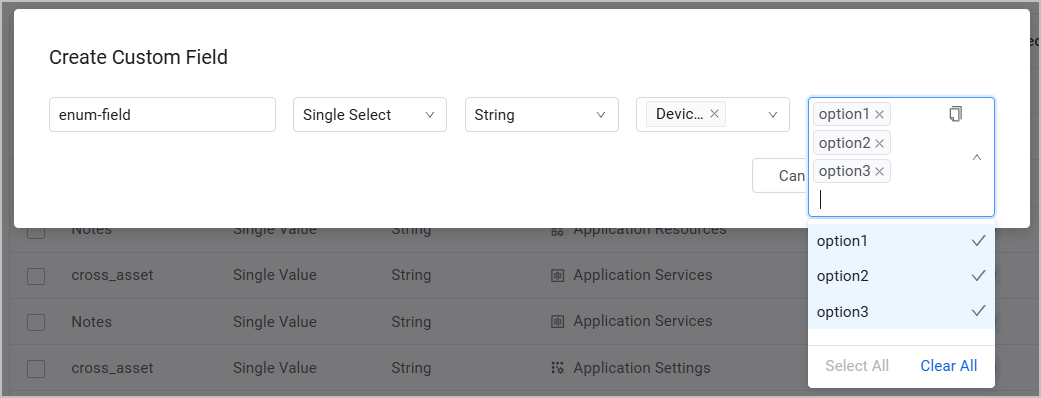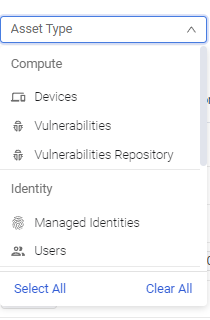Managing Custom Fields
Use Custom Data Management to manage all custom fields in the system from one central location without viewing the details of a specific asset.
Only users assigned the View system settings and Update system settings permissions (default for admins) can manage custom fields.

Custom fields are supported for all asset types.
There are three types of custom fields:
- Single Value - Allows the user to enter a single value into the field.
- Single Select - Allows the user to select one value from a specified list of values.
- Multiple Values - Allows the user to enter multiple values into the field. This is a list field.
To manage custom fields
- From the top right corner of any page, click
.png) , and in the Categories/Subcategories pane of the System Settings page that opens, expand Data, and select Custom Data Management.
OR
From the Manage Asset Custom Fields dialog, click the Manage Custom Fields button.
The Custom Data Management page opens.
, and in the Categories/Subcategories pane of the System Settings page that opens, expand Data, and select Custom Data Management.
OR
From the Manage Asset Custom Fields dialog, click the Manage Custom Fields button.
The Custom Data Management page opens.
.png)
The Custom Fields table shows all custom fields in the system that match the filter or search criteria, including all fields added to assets in their details page and fields added by Enforcement Actions.
The following information is included for each field:
- Field Name - The name of the field.
- Field Type - The type of field. Single Value, Single Select, or Multiple Values.
- Value Type - The type of data the field accepts. String, Date, Float, Integer, or Boolean.
- Asset Type - The asset type to which the field applies.
- Affected Assets - The number of affected assets for which the field has values. Click the number of Affected Assets to see a list of assets with their details.
- Field Values - The values assigned to the field. Values appear when the custom field is assigned to assets.
By default, the table includes all fields - those with and without affected assets. To see a list of fields only with no affected assets, toggle on Show fields with no Affected Assets. The list updates automatically every hour. The Last updated field indicates the date and time that the list was last updated.
Refreshing the Table
The table updates automatically every hour or when you create a new custom field from the Custom Data Management page.
You can manually update the table at any time, by clicking Refresh 
.png)
Adding a Custom Field
You can add as many custom fields as required.
To add a custom field
- In the upper-right corner of the Custom Fields table, click + Add Custom Field.
- In Enter Field Name, type a name for the field.
- In Field Type, select a data type. You can select Single Value, Single Select, or Multiple Values.
- In Value Type, select from the available options. Options change depending on the field type. Options may include: Boolean, Float, Integer, Date, or String.
- In Asset Type, select the asset category.
- When you create a Single Select field, in the right-hand dropdown, enter potential values to select from. To add a value, type comma(,), semicolon (;), or press Enter after the previous value. You can enter as many values as needed, but you must enter at least two values. You can also paste a list of multiple values from an external source, separated by commas, semicolons, or rows, into the values dropdown. To delete a value, hover over the value and click the X icon, or, from the dropdown list of values displayed below, hover over the value and click the V icon. You can also delete all values by selecting Clear All.

Note
Newly created custom Single Select values cannot include a comma(,) or semicolon (;) in the string.
- Click Create Field. A notification appears: 'Custom Field Created Successfully'. The table automatically refreshes and is updated with the newly added custom field. You can toggle on Show fields with no Affected Assets to filter the table to show only those fields with no affected assets, which includes the newly added custom field.
Note
The Create Field button is grayed out (i.e., disabled) until all details of the new custom field are filled in. In the example below, the Asset Type has not yet been chosen, and therefore the Create Field button is grayed out.
Copying Single Select Field Values
To copy the list of values you entered for a custom Single Select field, click the Copy selected tags icon  . Then, you can paste the list of values elsewhere.
. Then, you can paste the list of values elsewhere.

Filtering and Searching for Custom Fields
Use the filter bar at the top of the page to select criteria to filter the Custom Fields table. The table can be filtered by:
- Field Type
- Value Type
- Asset Type - Displays custom fields relevant for the selected asset type.
-
From the Asset Type dropdown, select one or more asset types to return the custom fields that apply to these asset types. For example: Users, Application Settings, Devices, Tickets. The assets in the dropdown are listed according to asset category (as on the Assets page). In addition, it is possible to type and search to easily locate in the dropdown, the asset type required.

-
You can also search the table according to Field Name, Field Type, or Asset Type by entering a search string in the Search field. This table is updated as soon as filter criteria are selected or a search string entered.
Click the column headers to sort the table.
Exporting the List of Custom Fields to CSV
You can export the list of custom fields to a CSV file. Only the currently listed items are exported.
To export the list of custom fields
- Click Export CSV. The file is generated and downloaded to the local computer.
Performing Actions on Custom Fields
Editing a Single Select Custom Field
From the Custom Fields table, you can edit one or more values of an existing Single Select custom field. This means that you can edit the Single Select custom field's list of values by doing any of the following:
- Modifying existing value(s).
- Adding value(s).
- Deleting value(s).
Note
You can never change the Field Type or Value Type of an existing field.
To edit Single Select custom field values
- In the Custom Fields table, optionally filter the table to show only Single Select custom fields.
- Hover over a Single Select custom field or a Single Select custom field
- Select Edit. The Edit Custom Field dialog opens with the list of values open.

- From here, hover over a value to delete it or add new values as explained in Adding a Custom Field.
- Click Save. The list is updated to reflect the changes. Note that you can only save your changes if there are at list two values entered.
Note
You can discard your editing changes by clicking outside the list of options (provided that you haven't yet clicked Apply).
Changing the values of fields in the Custom Data Management table only changes the values available to the users when selecting this field on the asset from this point onward. It does not change the values already configured on the assets themselves.
From the Custom Fields table, you can only edit the values of a Single Select custom field. You can edit Single Value and Multiple Values custom fields from the assets page, as described in Working with Custom Data.
Renaming a Custom Field
From the Custom Data Management table, you can rename a single custom field and repeat for each custom field that you want to rename. The new name appears wherever the field is used, affecting all assets with that custom field.
To rename a custom field
- Hover over a Single Select custom field or a Single Select custom field.
- Select Rename.
- In the Rename Field dialog that opens, enter a new name for the field.
- Click Save Changes. To see the changes, you may need to click the Refresh Data
 icon.
icon.
Deleting Custom Fields
From the Custom Data Management table, you can delete one or more custom fields. The deleted fields are removed from all affected assets.
To delete a custom field
- In the Custom Data Management table, hover over one custom field, or select one or more custom fields.
- Select Delete. You can also select all records on the page (mark the top left checkbox) or in the table (Select All), or clear your entire selection (Clear All). The system asks you to confirm the deletion.
- Click Delete Fields. The selected custom fields are completely deleted from the system. This cannot be undone.
Updated 2 days ago

